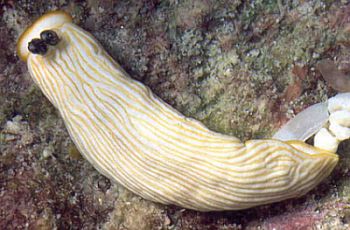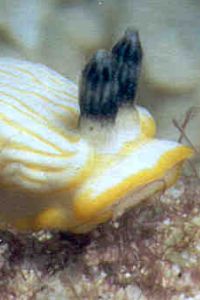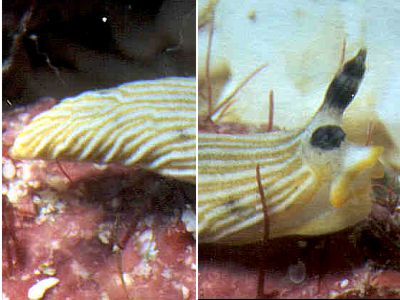
Dermatobranchus albus
(Eliot, 1904)
Order: NUDIBRANCHIA
Suborder: ARMININA
Family: Arminidae
DISTRIBUTION
Indo-West Pacific.
PHOTO
Pulau Hoga,Tukang Besi Archipelago, SE Sulawesi, Indonesia, approx 15m, November 1999. Upper: 15mm long. Lower: showing details of head (note eyes at base of rhinophores), and distinctly raised ridges. 12mm long specimen. Photos: Lindsay Warren.
Body with white ridges usually bearing a median yellow line. Between the ridges, the 'valleys' are a darker translucent grey or yellow. See Lindsay Warren's message below for a full discussion of colour variation and earlier descriptions.
References:
• Eliot, C.N.E., (1904). On some Nudibranchs from East Africa and Zanzibar. Part V. Proceedings of the Zoological Society of London, 2(1): 83-105.
• Edmunds, M. & Thompson, T.E., (1972). Opisthobranchiate mollusca from Tanzania IV. Pleurobranchomorpha, Dendronotoidea and Arminoidea. Proceedings of the Malacological Society of London, 40(3): 219-234, fig. 4.


Rudman, W.B., 2001 (June 8) Dermatobranchus albus (Eliot, 1904). [In] Sea Slug Forum. Australian Museum, Sydney. Available from http://www.seaslugforum.net/find/dermalbu
Related messages
Nudibranch feeding on Stolonifera
October 17, 2002
From: Michael Mrutzek

Hey Bill
Here is the other slug I mentioned in my other message. In my aquarium it will eat Stolonifera
types.
Is this interesting?
Michael
Michael@meeresaquaristik.de


Dear Michael,
Yes this is interesting. It is Dermatobranchus albus, which is apparently not uncommon throughout the Indo-West Pacific. However we have no information on what it eats. Other species of Dermatobranchus are known to feed on soft corals and gorgonians, so your report of it feeding on the related stoloniferans is not unusual. Can you give us any idea on the identity of the stoloniferan, or have you a photo perhaps?
Best wishes,
Bill Rudman
Dermatobranchus albus from SE Sulawesi [2]
June 10, 2001
From: Lindsay Warren

Dear Bill
To accompany the photos and details of Dermatobranchus albus found by Jean Coop in the Tukang Besi Archipelago, SE Sulawesi [Operation Wallacea], here are details of some additional specimens I found during last year's survey season. OS01007 (bottom photos)was found at the end of August 2000 in the afternoon at a depth of 5ft, size: 16mm, while OS01080 (upper right) was found in mid October at a depth of 28 ft, size: 22mm.
In looking up references on known species I came across Eliot's original description of Dermatobranchus albus (Eliot, 1904):
"Back white with distinct low ridges, longitudinal but not parallel to median line, each with a yellow line along its summit. The rhinophores stand vertically or point forwards and bear longitudinal perfoliations. The base is white, the main part black, the apex truncated and yellow. They are not retractile into pockets, but can be withdrawn under the mantle-edge. They are not very sensitive. The large velum and the mantle are edged with bright yellow. Foot not half the width of mantle. In crawling, the underside of the mantle is applied to the substratum over which the animal moves. Length 13 mm, breadth 4 mm."
And a further description of the same species (Edmunds & Thompson, 1972):
"The two animals were 16 and 9 mm long alive and they crawled actively in captivity. Dorsally the mantle has a series of almost parallel longitudinal ridges and grooves. The ridges have a yellow crest with white sides, and the grooves are grey. The edge of the mantle is yellow. Between the rhinophores the mantle is continuous with the head, unlike Armina which has a ridge and a groove here. The oral veil is white with a broad yellow anterior border. The rhinophores are white at the base with a yellow club and tip, but the club has dense black spots so appears dark. There are about eight longitudinal ridges on the club. The foot is rounded anteriorly with angled corners. Preserved, it is rounded with rounded corners. On the ventral surface, both the mantle and the foot are white. As usual in this family, there are openings of glands all along the edge of the mantle on the ventral side, but there are no lateral lamellae or gills such as occur in Armina. The smaller animal has a similar pattern to the larger one except that many of the yellow ridges on the mantle are discontinuous."
These seem to fit the specimens we found quite well. Without looking at internal anatomy at this stage, and considering that this D. albus has been described from the Eastern Indian Ocean, do you think it would be reasonable to think that Dermatobranchus albus could be the right id for the specimens we have found? The only difficulty with the external details is that there is no note on Jean's illustration as to whether the ridges were capped in yellow or whether yellow appeared in the grooves between the ridges although in the case of OS01007 it certainly looks as if there is a thin yellow line on top of the ridges with white walls and 'dirty' yellow grooves. Sadly I didn't pay attention to this when we found the various specimens and I had not found the above descriptions of D. albus.
• Eliot, C.N.E., 1904. On some Nudibranchs from East Africa and Zanzibar. Part V. Proceedings of the Zoological Society of London, 2(1): 83-105.
• Edmunds, M. & Thompson, T.E., 1972. Opisthobranchiate mollusca from Tanzania IV. Pleurobranchomorpha, Dendronotoidea and Arminoidea. Proceedings of the Malacological Society of London, 40(3): 219-234, fig. 4.
Looking forward to your comments.
All the best
Lindsay
alldcl@compuserve.com


Dear Lindsay,
I have had a look at my field notes of specimens I collected in east Africa and at least externally your animals fit Eliot's D. albus. There is usually a thin yellow line along the centre of the longitudinal ridges but what gets confusing, especially in dorsal photos is separating the ridges from the 'grooves'. The 'grey' colour between the ridges reported by Edmunds is really a translucent region, sometimes a colourless 'grey' but in other specimens a yellowish colour.
Best wishes,
Bill Rudman
Dermatobranchus albus from SE Sulawesi [1]
June 10, 2001
From: Lindsay Warren

Dear Bill
The first specimen of Dermatobranchus albus we found in SE Sulawesi was found by Jean Coop on 11 November 1999 at a depth of 14.2m on filamentous algae at the base of foliose coral. The location is a very calm 'bowl' surrounded by reef flat with its centre reaching a depth of 57 ft. The sides slope up gently and the whole place is full of delicate foliose corals. It is located on Pulau Hoga [Tukang Besi Archipelago, SE Sulawesi, Indonesia - Operation Wallacea]. Size: 15 mm - OWN206a (upper photo).
It has deep grooves (bright yellow) running along the length of the mantle with white ridges. The oral veil and foot are both white and edged with bright yellow. The bulbous rhinophores with vertical lamellae are black with two distinct lighter horizontal bands.
I found a second specimen (OWN206b) on the same dive at a depth of 12.5 m heading up on a piece of filamentous algae in an area of branching coral - it was wafting in the current. Size: 12 mm. This one had the same basic colouration but had some darker patches on the notum (lower right). Photos: Lindsay Warren.
They look very similar to Bob Bolland's Dermatobranchus sp. 1 from Okinawa.
All the best
Lindsay
alldcl@compuserve.com


Thanks Lindsay,
Bill Rudman
